
Testing the antigenotoxicity and anticytotoxicity properties of Prunella Grandiflora L. extract using the example of Drosophila Melanogaster
Abstract
Keywords
Full Text:
PDFReferences
Huang M, Wang Y, You M. Anti-tumor properties of Prunella Vulgaris. Springer International Publishing, AG; 2015, 401–419 p.
Xavier CP, Lima CF, Fernandes-Ferreira M, Pereira-Wilson C. Salvia fruticosa, Salvia officinalis, and rosmarinic acid induce apoptosis and inhibit proliferation of human colorectal cell lines: the role in MAPK/ERK Pathway. Nutr Cancer. 2009;61(4):564–571. doi:10.1080/01635580802710733
Rajendra NP, Karthikeyan A, Karthikeyan S, Reddy BV. Inhibitory effect of caffeic acid on cancer cell proliferation by oxidative mechanism in human HT-1080 fibrosarcoma cell line. Mol Cell Biochem. 2011;349(1–2):11–19. doi:10.1007/s11010-010-0655-7
Budantsev AL. Plant resources of Russia: wild flowering plants, their component composition and biological activity: Botanical Institute named after V. L. Komarova. St. Petersburg; 2008). 236–239 p.
Mukhopadhyay A, Vij Shubha S, Tyagi A. Overexpression of a zinc-finger protein gene from rice confers tolerance to cold, dehydration, and salt stress in transgenic tobacco. Proc Nat Acad Sci USA. 2004;101:6309–6314. doi:10.1073/pnas.0401572101
Plyusnina E, Shaposhnikov M, Moskalev A. Increase of Drosophila melanogaster lifespan due to D-GADD45 overexpression in the nervous system. Biogerontol. 2010;12(3):211–226. doi:10.1007/s10522-010-9311-6
Carmona ER, Guecheva TN, Creus A, Marcos R. Proposal of an in vivo comet assay using haemocytes of Drosophila melanogaster. Environ Mol Mutagen. 2011;52(2):165–169. doi:10.1002/em.20604
Irving P, Ubeda J, Doucet D, Troxler L, Lagueux M, Zachary D, Hoffmann J, Hetru C, Meister M. New insights into Drosophila larval haemocyte functions through genome-wide analysis. Cell Microbiol. 2005;7:335–350. doi:10.1111/j.1462-5822.2004.00462.x
Sharma A, Mishra M, Ram KR, Kumar R, Abdin MZ, Chowdhuri DK. Transcriptome analysis provides insights for understanding the adverse effects of endosulfan in Drosophila melanogaster. Chemosphere. 2011;82(3):370–376. doi:10.1016/j.chemosphere.2010.10.002
Delia D, Mizutani S. The DNA damage response pathway in normal hematopoiesis and malignancies. Int J Hematol. 2017;106(3):328–334. doi:10.1007/s12185-017-2300-7
Roos WP, Kaina B. DNA damage-induced cell death: from specific DNA lesions to the DNA damage response and apoptosis. Cancer Lett. 2013;332(2):237–248. doi:10.1016/j.canlet.2012.01.007
Goldstein M, Kastan MB. The DNA damage response: implications for tumor responses to radiation and chemotherapy. Annu Rev Med. 2015;66:129–143. doi:10.1146/annurev-med-081313-121208
Magombe N, Antosyuk ON, Bolotnik EV. Izuchenie protektornyh svojstv ekstrakta Prunella grandiflora L. otnositel'no vozdejstviya protivoopuholevogo preparata etopozid na primere Drosophila melanogaster. In: Abstracts of the Openbio VIII Mezhdunarodnaya nauchno-prakticheskaya konferenciya molodyh uchenyh: biofizikov, biotekhnologov, molekulyarnyh biologov i virusologov, 2021 Oct 5-8, Novosibirsk, Russia. p. 35–36.
DOI: https://doi.org/10.15826/chimtech.2022.9.2.S14
Copyright (c) 2022 Ngonidzaishe Magombe, Viktoria V. Kostenko, Olga N. Antosyuk, Elizaveta V. Bolotnik

This work is licensed under a Creative Commons Attribution 4.0 International License.
Chimica Techno Acta, 2014–2025
eISSN 2411-1414
Copyright Notice







